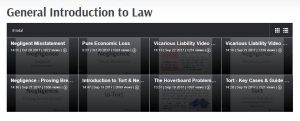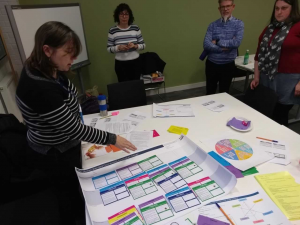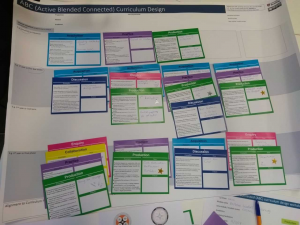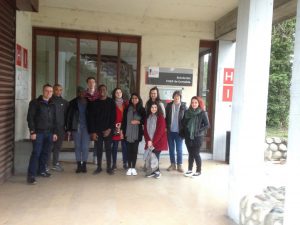Richard Mitchell, Computer Science, r.j.mitchell@reading.ac.uk
Preamble
Earlier in the year, Laura Bennett and I wrote a blog on making Word and PowerPoint accessible, which reflected our experience of implementing the University’s policy on Inclusive Practice in T&L, which is available here.
Since that blog was written, the University has included Ally into Blackboard, which provides academics with a view on how accessible our documents are and step-by-step guidance on how to make them accessible. In this blog I reflect on Ally and other developments, including the part of the recent Accessibility Audit Report from JISC which covered one of my courses.
Ally in Blackboard
As is explained on the TEL Support Site, Ally is an add on to Blackboard which allows students to download your teaching material in alternative formats (such as in HTML for view on mobile phone, electronic braille, etc) and it provides an accessibility score on your material as well as feedback and guidance to enable you to make the material more accessible. Instructors can see a colour coded dial with a percentage:




If low, the file is deemed not accessible and needs immediate attention; if medium it is somewhat accessible and could use improvement; if high it is accessible but could be improved; and occasionally the file is judged perfect.
If you click on the icon, you are presented with a screen with the score, and an option to see all the issues. You can then see what you need to do, and how the score can be increased – though so far there is guidance on only some of the issues.
I then go back to the original Word or PowerPoint file, make the appropriate changes, and re upload them to Blackboard. I can then get a new assessment by Ally, though I tend to have to wait for it.
The percentages given can seem harshly low – I had a document with two images which I had not added Alt Text to (one being the University crest), and the score was about 50%. The file became perfect when I added suitable text to those images. I gather that Ally considers the lack of Alt Text as a more pressing issue, which accounts for the scoring.
It should be noted that Word and PowerPoint’s built in checker is satisfied if you enter a Title or Description to any Alt Text, but Ally is happy only if there is a description – so is there any point in adding a title?
I am told that Alt-Text is read by screen readers, which explains why Ally considers it important – whereas a Title can be what is shown when a mouse hovers over the figure.
Ally can’t assess how useful your Alt Text is, just that it is there – so you should use your judgement.
As we noted in the original blog, you don’t have to be perfect – most of my PowerPoint documents are rated as High, with a score of 99% – the concern being about contrast issues, but as of writing there is no guidance on where the issue occurs. I am occasionally judged as Perfect which is nice! However, this may be more of a judgement call, as it is usually obvious when viewed on the screen. Blackboard suggests downloading this tool to fix contrast issues.
One issue Ally flags is untagged PDF files. If, say, your source document is a Word file, and you correctly use styles such as Title, Heading1, Heading2, Normal, etc. and then decide to produce a PDF, I recommend that you do so by saving the document as PDF, but just before saving, press the Options button in the dialog box, and ensure the Document Tags for Accessibility option is ticked.
I have come to the conclusion, however, that it is better to upload Word or PowerPoint documents, rather than PDFs to Blackboard. Students can readily download such documents (in whatever format) and can change them as they require – such as adding notes to PowerPoint slides, for instance.
Using Notes in PowerPoint
In 2017, I attended one of the public lectures I help to organise for the local IET on the Internet of Insecure Things. It was a very engaging lecture, comprising slides mainly composed of pictures, which the speaker in effect used as prompts. In contrast, if a slide comprises text which the speaker reads, albeit with some embellishments, a lecture can be dull.
However, from an accessibility point of view, such an approach does not provide much support. A solution to this is to use the notes section in PowerPoint. In fact, there is brief guidance in a few web sites which recommend that it is good practice if slides are decluttered and detail put in the notes section, though not specifically from an accessibility point of view.
I therefore experimented with one of my modules in the Spring term, where I simplified the text on slides, moving and embellishing some of the text into the notes section. The slides are less cluttered, and the students have access to the notes as they can download the PowerPoint from Blackboard, and they can add more detail if they want. That module went much better.
In 2018, JISC did an accessibility audit of some of the university pages and systems, and two courses in Blackboard, one of which being my second year Neural Networks module. It was noted that my lecture notes did not utilise the notes section, but that did not matter as sufficient information was there, and there were other resources on the module. However, I took it as affirmation that decluttering slides and using the notes section were good from an accessibility point of view.
Therefore, as I had planned, for this year I have reduced the amount of material on the slides for all my courses, and utilised the notes section. For this to be effective in the lecture room, the lecturer needs to use Presenter mode, where the students see the full slide, but the presenter on their screen sees, the slide, the next slide, and the notes section.
I asked IT for guidance on how this is achieved, as searches I did online did not help, and was told the following
The reason presenter mode doesn’t work in the lecture theatres is that although there are 2 physical screens, the system behaves as if there is only 1, it duplicates the first across all others.
This can be changed by holding the windows button + P. Then you can switch from ‘duplicate’ to ‘extend’ screens with the keyboard directional arrows + enter.
Once you have set the screen to extend, the PC will recognise 2 separate windows to operate with, and so presenter mode will work.
Please reset the room to the way you found it whenever you use this function, by pressing windows button + P and reselecting ‘duplicate’.
I have found that this works in some rooms – but not all, though I am lobbying.
What I can say is that I feel the lectures are going better, are more engaging, but it works best when the notes are visible (and hence provide some prompts) to the presenter.
Summary
From my experience, Ally is a useful tool for accessibility, though I do not have experience of students downloading material in alternative formats. There are some discrepancies between the assessment of accessibility between Ally and Word and PowerPoint, such as in the use of Alt Text. The score given by Ally seems disproportionate and it is a shame that you don’t get an immediate reassessment when you uploaded a changed version. It will be better when there is more guidance on addressing issues.
I also recommend the use of the notes section in PowerPoint, and believe it to be good practice in general and for accessibility. I hope that Presenter view will be working in all lecture theatres.



